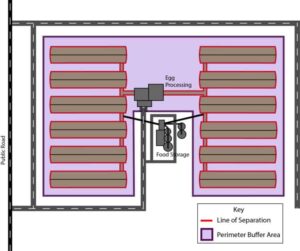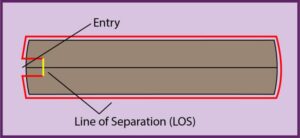The first few Jenga® blocks are always the easiest. A couple of taps to see which ones are loose and it’s pretty safe to remove a block. It is only as more blocks are removed and the tower starts to become weak and lean that the game gets exciting. Soon, the tower is only as strong as its weakest point in the structure. How many blocks can be removed before the tower topples over? We joke that in Jenga instead of one winner, there is only one loser. One person pulls the block that causes the tower to fall.
What if we started thinking of each of the 14 biosecurity principles of the National Poultry Improvement Plan like the blocks of a Jenga game? Just as the first couple of Jenga blocks are easy to remove, it is easy to remove or overlook some biosecurity measures. Before we know it, we have removed so many “blocks” that our program is weak, and one misstep can cause it to crash. Our biosecurity program is only as strong as the weakest link in the foundation.
Incorporating Jenga has been a fun way to teach the importance of biosecurity and sanitation. We know that biosecurity is a set of procedures intended to prevent the introduction and spread of disease, but going from theory to action is always a challenge How do we move from a definition to a mindset? How do we make sure not to overlook a single step in our biosecurity program? How do we move from our biosecurity measures only living on a piece of paper in the corporate office to something every farm employee cares about? It starts with understanding the importance of biosecurity.
Why do we care about biosecurity?
- Biosecurity impacts profitability.
Healthy birds = a healthy bottom line. Did you know, the total impact of the 2014-2015 HPAI outbreak in the Midwest (including trade) cost our industry more than $3 billion? - Protection from food-borne pathogens.
We strive to produce safe food for human consumption. We are continually improving the way we process food and our sanitation practices in the processing plant. Recalls affect the entire supply chain, and great biosecurity practices help minimize the risk of pathogen load moving from the farm into the processing plant. - Biosecurity is at the heart of every animal welfare program.
One of the five freedoms of animal welfare is “Freedom from pain, injury, or disease.” As animal caretakers, we want what is best for the animals under our care, striving to raise them as efficiently and humanely as possible.
Biosecurity Lines
Today, let’s focus on principles three and four from NPIP’s 14 biosecurity principles – biosecurity lines: perimeter buffer area and lines of separation.

Perimeter Buffer Area (PBA) – your first line of defense! The PBA can take many forms. It can be as sophisticated as a fence around a property or as simple as cut grass distinguishing the area from the field around your property. Either way, this area must be described or illustrated in your plan. There should be clearly written procedures (such as tire washes, etc.) that caretakers, visitors, and equipment must follow when entering and leaving the PBA.
Line of Separation (LOS) – your last line of defense! The LOS is the functional line that separates your birds from exposure to disease. Your biosecurity measures should be the strictest in this area and should include some form of entryway control. There are many products on the market for entryway control. Any product being utilized within a biosecurity program should be EPA registered and have the pathogens you are targeting listed on the label.
Entryway Control

At Sterilex, we are committed to providing you with the tools you need to enhance your biosecurity program and protect your flock. We believe that protection is prevention. Just like each Jenga block represents each biosecurity principle, we want to provide you with tools to make your foundation stronger.
FortiGuard, our foot pan powder, is an EPA registered disinfectant/sanitizer. It has gone through strict, third-party testing to prove that it kills organisms including Avian Influenza, Salmonella enterica, Staphylococcus aureus, Pseudomonas aeruginosa, E. coli, among other pathogens*. And, because it is EPA registered, it has been verified. The Sterilex Test Strip Kit can be used to quickly test and verify active ingredients are still stable– your most useful tool during an audit.
*See product label for full label claims and usage instructions.
Summary
Don’t let entryway control be the weakest link in your biosecurity program. There are many products on the market, but have you checked their labels? Are the products you are using specifically designed to protect your flock against disease or are they giving you a false sense of security that could cause your entire program to crash when disease threatens your flock?
For questions or more information on how FortiGuard can help protect your flock, visit our product page.